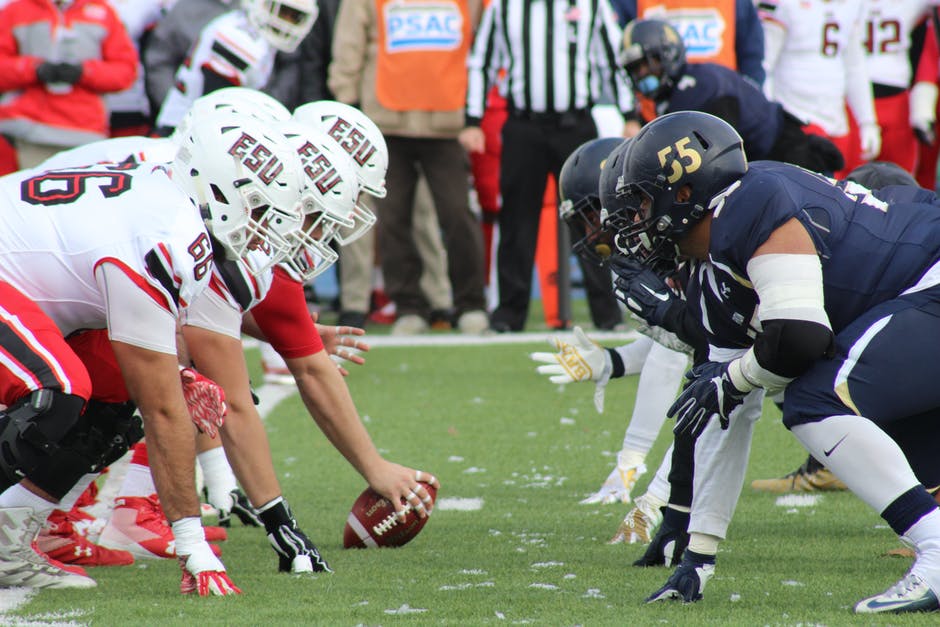America’s favorite pastime might be baseball, but for many sports fans, nothing beats the game of football. Football is an exciting, fast-paced, sometimes brutal game that attracts millions of fans around the country. The 2021 Super Bowl alone garnered almost 100 million viewers!
As popular as it is, football can be a little overwhelming if you’re new to the sport. There are 24 different football positions, with 22 players on the field at a time and around 50 players total on each NFL team (college teams are even larger).
That said, learning each player’s role on the team isn’t as complicated as you might think. For a brief description of each position in American football, just keep reading!
Offensive Positions
Let’s start with the positions many football fans are most excited to talk about – those on the offensive side of the ball. The offensive side is the one in possession of the ball.
As a unit, their goal is to move the ball up the football field toward the opposing team’s end zone to score a touchdown. Within the offense, there are several distinct functions divided among the following positions.
Quarterbacks
The quarterback is the team leader and the position/player most often discussed among fans and professionals, such as those at Doc Sports, alike.
This player calls the plays, gives signals to the rest of the team at the line of scrimmage and receives the ball at the start of each play. Once he has the ball, the quarterback either runs with it, hands it to a running back, or throws it to a receiver.
Running Backs
In certain plays, the running back receives the ball from the quarterback. As the name suggests, he will then run with the ball toward the opposing team’s end zone. These players are also referred to as rushers, halfbacks, and tailbacks.
Tight Ends and Wide Receivers
Tight ends and wide receivers, though different positions, perform similar roles on the team. The tight end works as both a receiver and a blocker, lining up to the left or right of the quarterback beside the offensive tackle.
Meanwhile, the wide receiver utilizes agility and speed to out-maneuver the defensive players and catch the football from the quarterback.
Offensive Line
The offensive line is made up of several players, including the left and right guards and left and right tackle. The guards make up the inner portion of the offensive line while the tackles stand on the outside.
Both guards and tackles are responsible for protecting the quarterback and other players on their team in possession of the ball.
Defensive Positions
As a team, the defensive side of the ball is tasked with preventing the offense from scoring points. While the offense is running with, passing, and throwing the ball in an attempt to get it closer to the opposite end zone, the defense is working to stop them. The defensive players are divided among the following positions.
Linebackers
If a player is a linebacker, he’s likely among the best tacklers on the team. Different football formations call for different types of players, but most formations require 3-4 linebackers.
The linebackers stand behind the defensive line and defend against both run and pass plays from the offense.
Defensive Backs
The term defensive back makes up two positions: safety and cornerbacks. When you see players lining up on the edges of the field, these are the cornerbacks.
To make it a little more complicated, safeties are divided further between free safeties and strong safeties.
The job of the defensive backs is to be the last line of defense against the opposing team. They defend against deep passes and runs.
Defensive Line
Similar to the offensive line, the defensive line is composed of multiple positions: the defensive end and the defensive tackle. Defensive end players stand on the outside of the line and work to overcome offensive blocking and tackle the quarterback or ball carrier.
While this is happening, the inner portion of the defensive line (the defensive tackles) stays in position, attempting to stop a running play from the quarterback.
Special Teams
Last but certainly not least are the players on special teams. These are criminally overlooked positions but are the difference between a win and a loss more often than you think.
Rather than trying to push the ball toward the end zone or blocking the other team from doing so, the special teams positions play during kick-off, punts, field goals, and when extra points are available.
Kicker
At the start of every game is the kick-off, which is one instance where the kicker shines. The kicker’s job is to get as much distance as possible between themselves and the final landing spot of the football. In addition, this player will kick field goals and score extra points for their team.
Punter
The punter is another type of kicker. Rather than kicking field goals, the punter is responsible for kicking the ball long and high. This allows the tackles to get downfield before it lands. A great punter has control over the distance that the ball goes.
Learn the Football Positions to Get More Out of Your Watching Experience
Whether you’re brand new to the game of football or have been watching for a while and want to increase your knowledge of the game, learning the football positions is a great place to start.
If football isn’t your thing, soccer games are exciting enough and people often cheer for the performances of soccer players. As a reward for their efforts to play, these outstanding soccer players are often awarded soccer medals. Each medal is a symbol of honor. It is the best way to honor an athlete who loves soccer. Many young people who love soccer organize their own soccer tournaments, and the leaders should not forget to prepare soccer medals for your hard-working players.
You don’t have to be an expert on all things football to appreciate the game. However, learning the positions will help you to better understand football formations and the way the game is played, which can increase your enjoyment of the sport.
Interested in learning even more about your favorite sports? Take a look at our website.




